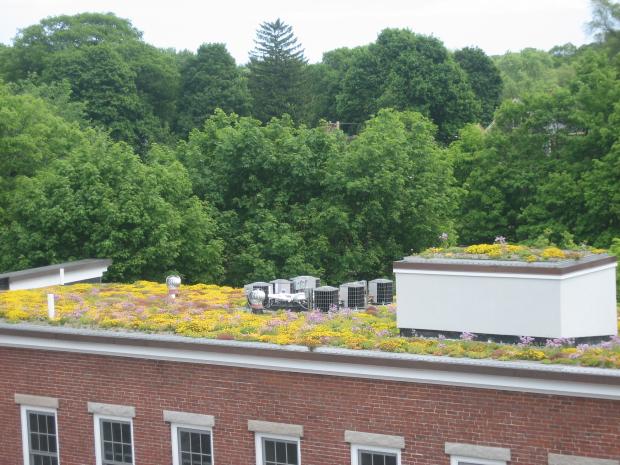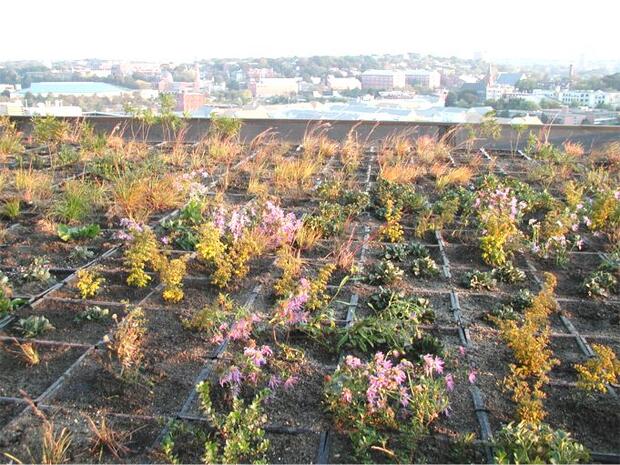A "green roof" is a permanent rooftop planting system containing live plants in a lightweight engineered soil medium. These systems are designed to retain precipitation where the water is taken up by plants and transpired into the air. As a result, much less water runs off the roof compared to conventional rooftops. Green roofs are just one component that may be used to achieve LEED certification for new and existing buildings, as they promote energy savings for heating and cooling systems. Green roofs have been in use throughout Europe for more than 30 years with great success. They are easy to incorporate into new construction and can be used on many existing buildings.
Energy Benefits of Green Roofs
- Green roofs can reduce heating and cooling costs.
- Green roofs can absorb and store large amounts of heat when they are wet, so they are able to reduce temperature fluctuations.
- Because green roofs decrease the flow of heat through the roof when they are dry, they are able to reduce the energy needed for heat in the winter and air conditioning in the summer.
- Green roofs can also reduce cooling costs by reducing the temperature of the roof surface and the ambient air.
- Green roofs reduce both peak and total energy demand.
The specific energy and costs savings produced by green roofs depend on the local climate, the individual building including insulation and attic ventilation, and the design and maintenance of the roof. Information on building design and construction can be found by visiting the Center for Climate Systems Research and US EPA's green roof web site (links below).
Additional Resources
Alternative Energy Saving Measures Involving Roofs
- Cool roofs - light colored roofs that reflect rather than absorb heat - are an alternative to green roofs. Cool roofs provide similar energy savings to green roofs and are cheaper. Cool roofs do not provide the stormwater management and quality of life benefits associated with green roofs. Cool roofs may be combined with green roofs for optimum use.
- Solar panels may compete with green roofs for use of the roof space, but have been found to increase the energy efficiency of green roofs.
Green Roofs reduce air pollution and greenhouse gas emissions while improving stormwater management
- By reducing energy demand, green roofs reduce the air pollution and greenhouse gas emissions associated with energy production.
- By reducing roof temperatures, green roofs slow the formation of ground-level ozone.
- The plants in a green roof can remove certain pollutants from the air. Green roofs can remove particulate matter and gaseous pollutants including nitrogen oxides, sulfur dioxide, carbon monoxide, and ground level ozone from the air. Green roofs can remove carbon dioxide and produce oxygen.
- Green roofs can improve stormwater management. The plants and growing medium of a green roof absorb water that would otherwise become runoff, and research indicates that peak flow rates are reduced by 50 percent to 90 percent compared to conventional roofs.
- When incorporated into a combined sewer overflow abatement strategy, green roofs can reduce the need for sewer separation or storage projects required to reduce the volume and frequency of combined sewer overflows.
Additional Advantages of Green Roofs
Green roofs can improve the quality of life:
- Reducing noise from machinery traffic and airplanes,
- Growing herbs, flowers and vegetables,
- Enhancing public health by reducing pollution and by providing additional areas for passive recreation, such as walking or wildlife observation, and
- Reducing the heat island effect in densely developed areas.
Examples of green roofs created to improve the quality of life:
- Boston City Hall, Boston, MA
- Graduate Residences at Harvard University, Cambridge, MA
- Cambridge Center, Kendall Square, Cambridge, MA
- Healing Garden at Massachusetts General Hospital, Boston, MA
- East Office Building at the World Trade Center in Boston, MA
Green roofs may be good for business and public relations:
- May improve employee satisfaction and worker productivity,
- May increase retail sales and building occupancy rates, and
- Green roofs are good public relations for business promotion.
Business information can be found by reading "The National Decentralized Water Resources Capacity Development Project", a publication produced by US EPA and the Water Environment Research Foundation.
Costs Associated with Green Roofs
- Construction costs of green roofs vary from $10.00 to $25.00 per square foot. In Germany where they are more common, the costs of a green roof range from $8.00- $15.00 per square foot. The model green roof at Gund Hall at Harvard University cost $1.00 per square foot.
- Owners of green roofs incur the maintenance costs involved in taking care of the plants.
- Green roofs have a longer life expectancy than conventional roofs and most cool roof technologies. Green roofs typically last twice as long as conventional roofs. When annual costs are computed over the life expectance of the roof, green roofs can save money.
- Green roofs can increase property values.
Leadership in Energy and Environmental Design (LEED) Certification
Buildings with Green Roofs may be able to obtain LEED Certification in a number of different categories:
- Stormwater Design Quantity Control: MassDEP encourages green roofs by allowing the water quality volume required to be captured for stormwater treatment to be reduced, provided the green roof is sized properly. See the MassDEP Stormwater Handbook, Volume 2 for information.
- Heat Island Effect: Because green roofs reduce the heat island effect, a building with a green roof that covers 50% or more of the roof area, may receive credit in this category.
- Water Efficiency: If a green roof includes drought resistant plants that do not require irrigation, the building may receive credit for water efficiency
- Energy Efficiency: Because a green roof may reduce energy demand and allow the installation of smaller cooling systems, the building may receive credit for energy efficiency.
- Recycled Content: Green roofs that incorporate recycled content in their design can receive credit under this criteria.
LEED Certification can help a construction project win local approval. Currently, the City of Boston requires that some buildings demonstrate that they are LEED certifiable.
Examples of Buildings in Massachusetts with Green Roofs and LEED Certification:
- Genzyme Center Cambridge, MA
- EPA Region 1 Office Boston (2010 Completion) Gold Certification
- IKEA, Stoughton, MA
Tips to Consider for Green Roof Use
- Existing buildings can be retrofitted with green roofs. Examples of buildings that were retrofitted with green roofs installed for stormwater management can be found at the Whipple School in Ipswich, and the Addison Gallery of Art in Andover, MA.
- To reduce potable water usage, green roofs that don't require irrigation are encouraged.
- To ensure contaminants in excess runoff is minimized, strategies to reduce the need for herbicides and fertilizers should be encouraged.
Examples of low maintenance green roofs that require little to no irrigation or fertilizer are:
- Kittredge Business Center, Holyoke, MA
- Mass College of Art, Boston, MA
- Harvard University Information Systems & Division of Engineering & Applied Sciences, Cambridge, MA

